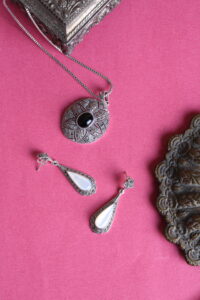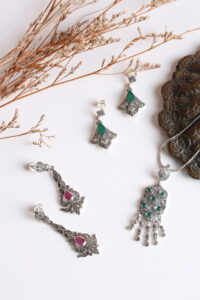Precious metals have been used in jewelry for centuries, offering beauty, durability, and value. Gold, silver, and platinum are the most commonly used metals in fine jewelry, each with its own unique properties, benefits, and care requirements. Understanding these differences can help you make informed decisions when purchasing or caring for your jewelry. Whether you are buying jewelry for investment, daily wear, or special occasions, knowing the characteristics of each metal will guide you toward the right choice.
Understanding Precious Metal Types: Gold, Silver, Platinum

Gold: The Classic Precious Metal
Gold is one of the most popular metals for jewelry, known for its timeless appeal, versatility, and inherent value.
Types of Gold
- Yellow Gold: The natural form of gold with a warm hue, alloyed with copper and silver to enhance durability.
- White Gold: Created by mixing gold with metals like nickel or palladium and often plated with rhodium for a bright, white appearance.
- Rose Gold: Made by alloying gold with copper, giving it a soft pink or reddish tone.
- Green Gold: A rare type of gold that contains silver, resulting in a greenish-yellow hue.
Gold Purity Levels
Gold is measured in karats (K), indicating the percentage of pure gold in the alloy:
- 24K (99.9% pure gold): The purest form of gold, but very soft and prone to scratching, making it less ideal for daily jewelry.
- 18K (75% pure gold): A popular choice for high-end jewelry, offering a balance of purity and durability.
- 14K (58.3% pure gold): Commonly used in everyday jewelry as it is more resistant to scratches while maintaining a rich color.
- 10K (41.7% pure gold): The most durable and affordable option but contains a higher percentage of alloy metals.
Pros and Cons of Gold Jewelry
Pros:
- Available in different colors to match personal preferences.
- Resistant to tarnishing and corrosion.
- Retains intrinsic value over time.
Cons:
- Higher karat gold is softer and more prone to scratches.
- White gold requires periodic rhodium re-plating to maintain its shine.
Silver: Affordable Elegance
Silver is a beautiful, budget-friendly metal widely used in jewelry. Its bright luster and affordability make it a favorite choice for both casual and fine jewelry.
Types of Silver
- Sterling Silver (925 Silver): Composed of 92.5% pure silver and 7.5% other metals (usually copper) for added strength.
- Fine Silver (999 Silver): 99.9% pure silver, softer and more prone to scratches.
- Argentium Silver: A modern silver alloy containing germanium, which makes it more tarnish-resistant.
- Coin Silver: Contains around 90% silver, historically used in U.S. currency and some antique jewelry.
Pros and Cons of Silver Jewelry
Pros:
- More affordable than gold and platinum.
- Versatile and suitable for various jewelry styles.
- Easy to maintain with regular polishing.
Cons:
- Prone to tarnishing and oxidation over time.
- Softer than gold and platinum, making it less durable for everyday wear.
- Some silver alloys may cause skin reactions in individuals with metal sensitivities.
Platinum: The Ultimate Luxury Metal
Platinum is a rare and valuable metal known for its durability, hypoallergenic properties, and natural white luster.
Key Features of Platinum
- Durability: One of the most durable metals, highly resistant to scratches and tarnish.
- Hypoallergenic: Ideal for individuals with metal allergies.
- Natural White Color: Unlike white gold, platinum does not require rhodium plating.
- Heavy and Luxurious: Platinum is denser than gold and silver, giving it a substantial feel.
Pros and Cons of Platinum Jewelry
Pros:
- Extremely durable and resistant to everyday wear.
- Retains its white color permanently.
- Hypoallergenic and safe for sensitive skin.
Cons:
- More expensive than gold and silver.
- Develops a patina over time, requiring occasional polishing.
- Heavier than other metals, which may not be ideal for those who prefer lightweight jewelry.

Comparing Gold, Silver, and Platinum
Durability: Platinum is the most durable, followed by gold, while silver is the softest. Affordability: Silver is the most budget-friendly option, gold is mid-range, and platinum is the most expensive. Skin Sensitivity: Platinum is hypoallergenic, while white gold may cause reactions due to nickel content. Color Options: Gold comes in yellow, white, and rose varieties, while silver and platinum maintain their natural white tones.
Choosing the Right Metal for Your Jewelry
When selecting a metal for your jewelry, consider the following factors:
- Budget: Silver is the most affordable, gold is mid-range, and platinum is the most expensive.
- Durability Needs: Platinum is best for everyday wear due to its strength, while 14K gold offers a balance of durability and beauty.
- Aesthetic Preference: Choose between the warm tones of yellow gold, the sleekness of white gold/platinum, or the affordability of silver.
- Skin Sensitivity: Platinum is the best hypoallergenic choice, while some people may have allergies to nickel in white gold or certain silver alloys.
- Occasion: Platinum is ideal for engagement rings and heirloom pieces, gold is suitable for both formal and casual wear, while silver is great for fashion jewelry.
Caring for Precious Metal Jewelry
To maintain the beauty and longevity of your jewelry, follow these care tips:
- Gold: Clean with mild soap and water, polish with a soft cloth, and store separately to prevent scratches.
- Silver: Use a silver polishing cloth or anti-tarnish solutions to maintain its shine. Store in anti-tarnish pouches.
- Platinum: Wash with mild soap and water, and take it to a jeweler for occasional polishing to maintain its natural shine.
- General Care Tips: Avoid exposing jewelry to harsh chemicals, remove jewelry before swimming or exercising, and store in lined jewelry boxes.
Understanding the differences between gold, silver, and platinum helps you choose the best metal for your jewelry collection. Whether you prefer the classic appeal of gold, the affordability of silver, or the luxurious durability of platinum, each metal has unique advantages. By considering factors like durability, budget, and skin sensitivity, you can select the perfect metal to match your style and needs. Proper care and maintenance ensure that your jewelry remains beautiful and valuable for generations to come.




